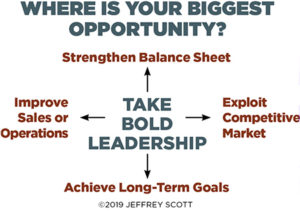 “Continuous improvement” has been popular for years, going back to post-World War II, when the now famous American management consultant W. Edwards Deming helped Japan reinvigorate its economy after the war.
“Continuous improvement” has been popular for years, going back to post-World War II, when the now famous American management consultant W. Edwards Deming helped Japan reinvigorate its economy after the war.
But sometimes continuous improvement can be too slow to get results we need. Business operates much quicker than it did back in the 1950s. Today, you may need to simply take a sharp right turn on the big issues to make a larger impact on your business.
I call this type of decision-making “bold leadership.”
If you rely only on incremental improvement, here are some of the consequences you can expect:
- Entrenchment. It can be difficult to change the minds of conservative members of your team. Taking the slow approach can, at times, dilute the momentum needed for lasting change.
- A moving target. When your goal is higher profit, it can be difficult to achieve with the incremental approach because companies tend to build overhead over time. This pushes the profit targets further into the future.
- Demotivation. When profit sharing, bonuses and even raises are tied to improving performance, employees can lose faith when your goals take longer (or too long) to hit.
- Wrong change. With a culture of continuous improvement, you run the risk of making change for change’s sake, improving things that are not broken. And when you focus on small changes, you may miss the big opportunity right in front of you.
On the flip side, for those of you willing to embrace “bold leadership,” there are many benefits. Here are a few:
1. Making a deeper impact through focus.
2. Gaining increased respect and attention of your team. When they see that their leader is making bold decisions — as long as those decisions are calculated and thoughtful — they will get on board.
3. Catching the competition off guard. When you (their competition) make a sharp right turn, you’ll surprise them. Let them follow you, not the other way around!
Getting started with “bold leadership”
Pick a big challenge or opportunity your company is facing. For example, it might be lack of personnel, lack of profit, lack of cash, lack of space or lack of quality lead flow.
For the sake of discussion, let’s pick lack of profit. I just got off the phone with a contractor talking about this challenge. The contractor in question was not aware he had a lack-of-profit issue. When he started working with me last year, the company was at 4.9 percent net profit. After a couple months, we were on track to hit 15 percent net profit. That seems wonderful, but there were two flaws:
- The company counted on a large sales spurt to grow into profits.
- It didn’t budget in a sufficient market-based salary. At $125,000, the owner was actually underpaying himself compared to provable market rates.
When we rectified those two factors, the projected profit shrunk. So, I asked him to replan with this question in mind: “What would you have to change in your marketing, sales and operational strategy in order to achieve a 20 percent net profit?”
We worked through this question and developed some “bold leadership” strategies and tactics. The team morale was higher than ever, and now was the time to strike.
Put it into action
What would have the biggest impact on your company’s current health and performance if you used “bold leadership”?
To answer this, look at the figure “Where Is Your Biggest Opportunity?” above and identify where your biggest impact can or needs to be achieved. It might be in your balance sheet, in your marketplace, in sales, in operations or it might be outlined in your long-term goals.
Find where you can have the biggest strategic impact now and go forth in a bold manner.

